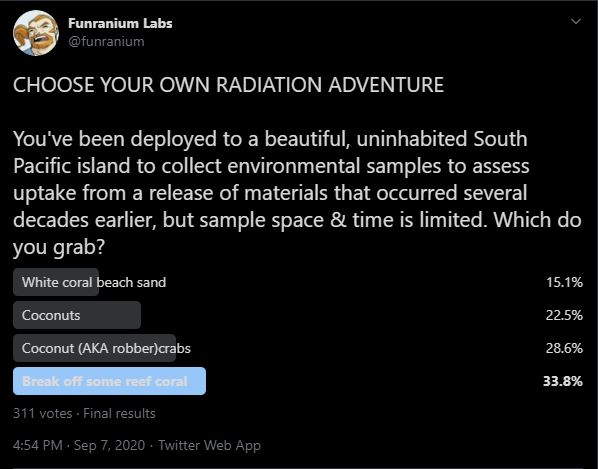Since I used the word earlier today, “extended, unplanned deployment to an uninhabited island” is an excellent euphemismspeak for being marooned.
Luckily, you aren’t marooned. You’ve just been sent in on a zodiac raft to get samples while boss-type sips coffee back on the boat.
[The third in an ongoing series of my compiled explainers for my CHOOSE YOUR OWN RADIATION ADVENTURE quizzes. There’s never really a right answer but some might work out better under the constraints of the scenario. It’s like poetry, really.]
In an ideal world with infinite funding & space, you grab all these samples and more. Why limit yourself to mere coconuts when you can take an entire tree? Yes, I have seen a crate labeled “ONE [1] PALM TREE, ENIWETOK” before. Oh, how the money must have flowed in those days. But, no, you’re working as an afterthought in the Twilight of Big Science to do the monitoring of the sins of the past. You’re overhead, likely as part of a regulatory requirement or lawsuit settlement. Congratulations! You are the bare minimum good faith effort.
Which is why you were sent to go grab a samples really quick. Because every minute you spend on the island is one that the boat is in the water and a crew has to be paid. As discussed earlier in the Navy base decon adventure, any work that is done on water adds a serious cost multiplier. If you’re of the frame of mind “The sooner I do this, the sooner I get to have beers”, then you don’t even need to hit the beach. Break off a piece of coral from the reef like a Kit Kat bar, put it in your cooler, and head back to the boat. MISSION ACCOMPLISHED!
As a sample, coral is pretty great for sampling and sequestering material as the reef slowly grows if there is persistent material in the lagoon for the polyps. But the reef is also continuously washed by the rest of the ocean, diluting that signal. If there isn’t a persistent, perceptible presence of material in the lagoon, there will be one season (The Event) in the coral skeleton you can detect and then nothing. This makes it look like the island is now clean when really it’s just that the reef is continuously flushed. Corals grow just like trees, marking the seasons with layers, but they’re really, incredibly slow by comparison. Which is one reason a lot of you winced at the idea of doing a smash & grab on the reef. You have good impulses. :)
So you look further up the beach and see the coconut palms, the dropped coconuts at the high tide line, and some very large shell-less hermit crabs between you and them. As a reminder, coconut crabs are these. They are the largest land arthropod in the world and have claws that *tear coconuts apart*. You can totally outrun one, but can you avoid the minefield of all of them? Do you dare steal their precious coconuts?
And this is how the nine-fingered researcher introduced me to the coconut crab that lived in his lab freezer. It cost a finger and a fair bit of blood to get those samples and he was proud of it even 20 years later. I would like you to know that the crab took up more than half of his full size freezer.
His advice, “Coconuts only hurt if they fall on you.”
~fin~
